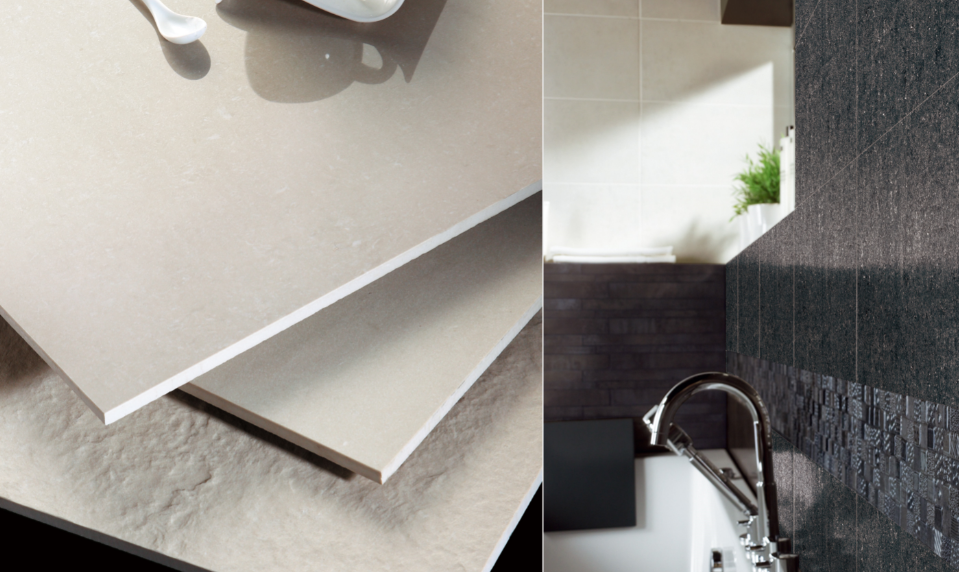
Ceramic tiles are classic and a popular choice for many looking to add a splash of color to their homes, which come in a wide variety of colors. Ceramic tiles are created by using all-natural clay and heating it in a kiln at very high temperatures. Ceramic tiles come in a wide variety of colors.
Ceramic tiles may be glazed to improve their ability to withstand moisture and water, although some tiles are not glazed.

Vitrified tiles, while similar in appearance to ceramic tiles are different in their composition and strength. Vitrified tiles are created through a process known as vitrification. Vitrification – from the Latin for glass – is the process in which a substance is transformed into a glass-like compound. Vitrification in this instance refers to the adding of silica, quartz, and feldspar, which when fired give the tiles a shiny, glass-like characteristic.The clay is mixed with quartz and feldspar before being heated in the oven.These extra ingredients melt, creating a glass element within the tile. This glass component makes the vitrified files very hard and resistant to any type of absorption.
Beyond the characteristic shininess, the vitrification process also makes the tiles much less porous, much harder and less absorbent than traditional ceramic tiles. Vitrified tiles, when scratched, will retain a consistent, all over color. In this way, they differ from ceramic tiles, where the color is usually only on the exterior surface. In vitrified tiles, the dye is mixed with the clay before firing, meaning the color is uniform throughout the tile.
Homeowners can use both ceramic or vitrified tiles for any number of household purposes. These tiles are especially popular for backsplashes, countertops, and floors. When considering tiles for the outdoors, the choice for which tiles to use becomes simple. Vitrified tiles have a much lower absorption rate than ceramic tile, making them perfect for outdoor use. Vitrified tiles are also better for use in moist areas, such as laundry rooms and bathrooms.
Vitrified tiles, unlike ceramic tiles, are rarely glazed. Instead, a dye is mixed in with the clay before it is fired. This dye makes the clay a uniform color, so even if the vitrified tile is scratched, the color will stay the same. Instead of being glazed, vitrified tiles are either polished or unpolished. Polished tiles have a bright sheen, while unpolished versions are rougher and have a more natural look.
The prices of ceramic tiles vary considerably, depending on the size and personalized work. They tend to cost between $ 8 and $ 20 dollars per square foot.
Ceramic tile prices range considerably, depending on custom work and size. They tend to cost between $8 and $20 dollars per square foot. Vitrified tiles cost a couple of dollars more per square foot because of their extra qualities. Vitrified tiles also need a stronger adhesive than ceramic tiles, which can cost more in installation.
Ceramic tiles – Direct exposure to sunlight will cause the color of the tiles to be removed frequently and the tiles may fade for a period of time.
While Vitrified Tiles has no sunlight effect on this type of tile, as the color will remain for a period of time.
Unlike ceramic tiles, vitrified tiles are rarely vitrified. Instead, a dye is mixed with the clay before being burned. This dye makes the clay a uniform color; therefore, even if the vitrified tile is scratched, the color will remain the same.
Instead of being vitrified, vitrified tiles are either polished or unpolished. Polished tiles have a shiny sheen, while unpolished versions are rougher and more natural-looking.
The ceramic tiles are comparatively rough and the outer enamel is applied for the shiny appearance.
While Vitrified Tiles is smooth and shiny. Therefore, it offers an aesthetic appearance and is easy to clean.
The tiles are very porous and therefore absorb water quickly. Therefore, the use of ceramic tiles in the external area will cause the tiles to develop cracks quickly.
Meanwhile, the vitrified tiles are not porous and therefore the water absorption is negligible. Therefore, it is more suitable for wet areas.
Ceramic and vitrified tiles, both can be used on walls and floors. Both types of tiles are available in different varieties of colors, design patterns, and sizes.
Although they are used for the same purpose, there is a big difference between ceramic and vitrified tiles, that is, their properties, availability, cost, etc.
So here we try to provide a brief comparison between ceramic tiles and vitrified tiles, which will help you to make the right choice.
As mentioned earlier, the composition varies. The ceramics are made with clay, while the vitrified tiles contain a mixture of silica and clay.
Ceramic tiles china have a thicker texture than vitrified tiles, known for their shiny appearance. However, ceramic tiles have a more natural and earthy appearance than vitrified tiles, whose glassy appearance gives an artificial touch.
Due to their low porosity, vitrified tiles absorb very little water when compared to tiles. This makes vitrified tiles a good option for floors.
Vitrified tiles are more resistant to scratches and stains than ceramic tiles. Ceramic tiles are easier to install.
Finally, due to the obvious advantages of vitrified tiles, they cost more than ceramic tiles
Armed with these basic factors, you can easily distinguish the two types of pieces with just one look. You can also analyze which type of tile matches which purpose and install each according to its qualities.
Copyright © 2021 Guangzhou Weyes Network Technology Co., Ltd. | All Rights Reserved